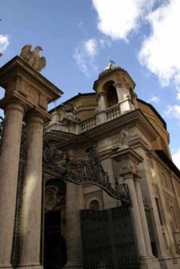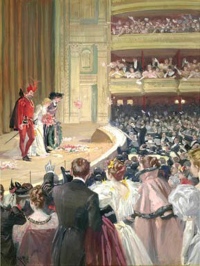Knowledge Bytes
Internet Sites Selected for the Readers of Duke University Libraries
Amazing Grace
http://memory.loc.gov/cocoon/ihas/html/grace/grace-home.html
The Library of Congress has created a website devoted to the history of the hymn “Amazing Grace” and the Library’s Chasanoff/Elozua Amazing Grace Collection, which comprises 3,049 published recordings of the hymn by different musicians or musical ensembles. This site is a joint venture of the Motion Picture, Broadcasting and Recorded Sound Division; the Music Division; and the American Folklife Center.
Since its publication in 1779 in England, “Amazing Grace” has grown in popularity to become one of the best-known musical works in the world. This website explores its history through items in the collections of the Library of Congress, from the earliest printing of the song to various performances on sound recordings.
The audio collection and database, compiled by Allan Chasanoff and Raymon Elozua and given to the Library in 2004, is listed in the Guinness Book of Records as the largest collection of recordings of a single musical work. The website contains a number of selections from the collection, including gospel renditions by Sister Rosetta Tharpe and the Mighty Clouds of Joy, an Elvis Presley recording, country versions by Johnny Cash and Willie Nelson, and rock interpretations by the Byrds and the Lemonheads. A database for the entire collection can be searched on the site, and the complete audio collection is available for listening in the Library of Congress’s Recorded Sound Reference Center.
Reflecting Antiquity: Modern Glass Inspired By Ancient Rome
http://www.getty.edu/art/exhibitions/reflecting_antiquity/
 The art of the Romans has influenced the work of many generations of artisans. Exploring Roman forms and subjects has been a worthy endeavor for centuries, and many careers have been made of interpreting their work, much as the Romans drew on the work of earlier Grecian artisans. This fascinating online exhibit from the J. Paul Getty Museum examines the ways in which Roman glass was used as inspiration for glassmakers across Europe in the late 1700s and early 1800s. Created to complement an ongoing exhibit at the Getty Villa, this exhibit affords visitors the opportunity to learn about mosaic glassmaking techniques, cameo glass, gold glass, cage cups, and the shimmering world of iridescence. Each section of the exhibit includes a brief narrative paragraph, along with high-quality examples of each glassmaking technique. Additional features include audio-visual demonstrations of glassmaking and a place where visitors can post their own comments.
The art of the Romans has influenced the work of many generations of artisans. Exploring Roman forms and subjects has been a worthy endeavor for centuries, and many careers have been made of interpreting their work, much as the Romans drew on the work of earlier Grecian artisans. This fascinating online exhibit from the J. Paul Getty Museum examines the ways in which Roman glass was used as inspiration for glassmakers across Europe in the late 1700s and early 1800s. Created to complement an ongoing exhibit at the Getty Villa, this exhibit affords visitors the opportunity to learn about mosaic glassmaking techniques, cameo glass, gold glass, cage cups, and the shimmering world of iridescence. Each section of the exhibit includes a brief narrative paragraph, along with high-quality examples of each glassmaking technique. Additional features include audio-visual demonstrations of glassmaking and a place where visitors can post their own comments.
Vatican Museums Online
http://mv.vatican.va/3_EN/pages/MV_Musei.html
 For those of us who are not able to travel to the museums of the Vatican, this website may be the next best thing. The site transports visitors to the Sistine Chapel, the Gregorian Egyptian and Etruscan museums, the Pinacoteca, and the Ethnological Missionary Museum. Visitors can take 360° tours of each museum’s rooms and view each object in context, then examine the contents of each room in detail. All the exhibits are lovely, but the Sistine Chapel deserves special attention. Here viewers can zoom into portions of The Last Judgement and the Chapel ceiling to study each figure. Tools make it possible to enlarge portions of the image, zoom, and scan each work of art. Very informative and helpful descriptions of the works of art complete this notable website.
For those of us who are not able to travel to the museums of the Vatican, this website may be the next best thing. The site transports visitors to the Sistine Chapel, the Gregorian Egyptian and Etruscan museums, the Pinacoteca, and the Ethnological Missionary Museum. Visitors can take 360° tours of each museum’s rooms and view each object in context, then examine the contents of each room in detail. All the exhibits are lovely, but the Sistine Chapel deserves special attention. Here viewers can zoom into portions of The Last Judgement and the Chapel ceiling to study each figure. Tools make it possible to enlarge portions of the image, zoom, and scan each work of art. Very informative and helpful descriptions of the works of art complete this notable website.
Met Archives: The Metropolitan Opera
http://www.metoperafamily.org/metopera/history/
 Although it is too late to hear Lilli Lehmann sing “Liebestod” live from the Metropolitan Opera or Caruso offer his version of “Questa o quello” from Verdi’s Rigoletto, these wonderful performances are revived on this very engaging website. First-time visitors may want to read the introductory essay on the history of the Met and then proceed to the “Timeline of Metropolitan Opera History.” In the “MetOpera Database” visitors can search for information about productions from any period of the institution’s history. Here you can learn, for instance, that La Bohème was performed a total of 1193 times at the Met between 1900 and June 2007, whereas Lucrezia Borgia and Gallia have been performed only once. Visitors can also peruse the “Stories of the Operas” section to read brief summaries of such works as Tristan und Isolde, Lucia di Lammermoor, and Die Fledermaus.
Although it is too late to hear Lilli Lehmann sing “Liebestod” live from the Metropolitan Opera or Caruso offer his version of “Questa o quello” from Verdi’s Rigoletto, these wonderful performances are revived on this very engaging website. First-time visitors may want to read the introductory essay on the history of the Met and then proceed to the “Timeline of Metropolitan Opera History.” In the “MetOpera Database” visitors can search for information about productions from any period of the institution’s history. Here you can learn, for instance, that La Bohème was performed a total of 1193 times at the Met between 1900 and June 2007, whereas Lucrezia Borgia and Gallia have been performed only once. Visitors can also peruse the “Stories of the Operas” section to read brief summaries of such works as Tristan und Isolde, Lucia di Lammermoor, and Die Fledermaus.
Thanks to the Internet Scout Project (Copyright Internet Scout Project, 1994-2008. http://scout.cs.wisc.edu/) for identifying these sites. If you would like to recommend a Web site for inclusion in a future issue of Duke University Libraries, contact Joline Ezzell at joline.ezzell@duke.edu.

